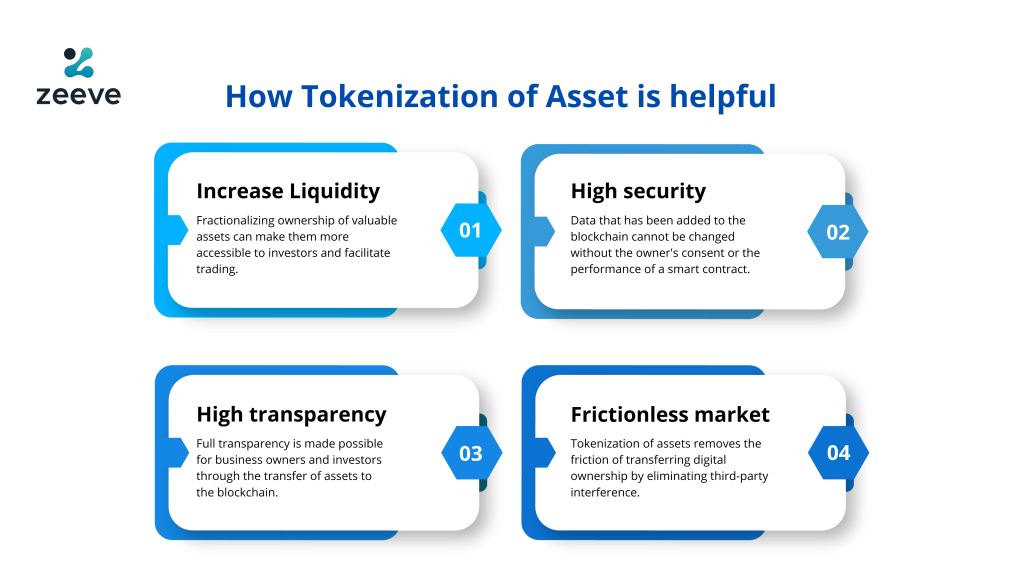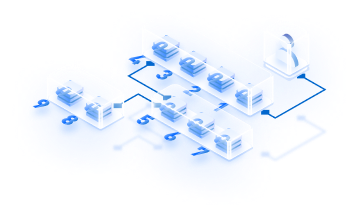Blockchain is often thought of being just an immutable ledger but the true powers of this new piece of technology go beyond just a secure database. Blockchain-based Tokenization of Assets is changing the way assets are managed and traded.
The immutable ledger blockchain acts as a single source of truth for any data stored in it, usually for transactions. Therefore, a Blockchain network having an immutable database becomes a credible and auditable system.
Credible because one cannot modify the data stored on the ledger. Auditable because the transaction data can be traced back to its origin. Moreover, the consensus mechanism of Blockchain that governs the addition of data into the ledger eradicates the need for a third party.
Tokenization of Assets and Blockchain
The underlying immutable ledger of the Blockchain network has allowed numerous use cases to become feasible.
For instance, let’s imagine the transactional data stored inside a Blockchain network’s ledger represents the ownership of an asset. In this case, the asset is digitized as it exists in the network’s ledger. If the asset goes through any activity in real life, such as a transfer of ownership, it will reflect on the chain. This is a classic example of how tokenization is used for the digitalization of an asset.
This, on a broader level, is the concept of Blockchain-based tokenization.
Tokenization is implemented by issuing a specific number of tokens on the Blockchain. The combined value of these tokens is equal to the value of an asset in real life.
It is important to consider that the concept of tokenization is not new. It has just become more feasible with the advent of Blockchain. Blockchain allows the storage and transfer of the tokens over the network in a frictionless manner.
What is a token?
Tokens can be considered as entries in a digital ledger that are governed by pre-written rules and regulations specified in a smart contract. Every token is in a specific block of the Blockchain, and the transfer of ownership of a token means that the public address associated with that token is changed.
The token management and access are usually done through a wallet that holds the public and private keys of the owner. The public key in the wallet is linked to the token on the Blockchain, while the private key is used to authenticate any activity to be done on the token.
Tokens can be classified into two categories – utility tokens and security tokens.
Utility tokens are used to facilitate financial activities in a particular ecosystem. For instance, we go to a theme park and buy tickets to enjoy various rides inside that theme park. In a similar sense, a utility token is used inside a digital ecosystem for various activities.
Security tokens, on the other hand, are the digital representation of security. Security tokens come in different types as they can represent different securities. The most prominent types of security tokens are:
- Equity tokens – Equity tokens are stocks on Blockchain. Just as traditional stocks represent the equity in a company, equity tokens are used to implement the same concept with the only difference being that these tokens are stored, issued, and managed on the Blockchain network, supercharged with trust and transparency along with a lower processing fee.
- Debt tokens – Tokens used to represent debt instruments such as real estate mortgages and corporate bonds on a Blockchain network are called debt tokens. To eradicate the risks such as debt default or dramatic changes in the valuation, smart contracts used to issue these debt tokens can be programmed to include certain rules such as repayment terms.
- Derivate tokens – These tokens derive their value from another token or an underlying asset. The underlying asset goes through a verification process to establish ownership and then the user receives tokens having equal value to the asset. These tokens can be used for various purposes such as getting a loan or trading.
- Hybrid convertible tokens – Hybrid tokens, as one might presume, can be made by mixing any two token types. These tokens are generally a mix of debt and equity tokens, convertible in either of them.
- Real asset tokens – These are used to represent the ownership of real-life assets on a Blockchain platform. Real asset tokens are the most significant types of tokens that have been the talk of the Blockchain space for some while now. They are used to represent assets such as commodities, real estate, and art.
The classification mentioned above is done based on the usability of a token. However, when it comes to the core definition of tokens, they are classified into the following two types:
Fungible: Fungible tokens are used to represent any exchangeable, replaceable asset digitally. The most common example of a fungible token is the digital representation of a dollar. Every token representing a dollar will have the same value. It does not matter which person owns which token as they are all the same.
Non-Fungible: Non-fungible tokens are used to represent unique digital assets that have an intrinsic value. The most common example of NFTs is the digital representation of digital collectibles. Different attributes of artwork are used to represent it on the network and its ownership is defined exclusively. Learn more about NFTs here.

Benefits of Tokenization of Assets
- Trust and Transparency – The tokenization of an asset provide more transparency as it opens up the doors to a global platform by representing that asset digitally.
- More Liquidity – Tokenization also provides more liquidity as an asset being tokenized can be bought and sold in parts rather than as a whole – Fractional Ownership.
- Hassle-Free Secondary Market – Tokenization of assets removes the friction when it comes to the trading of these assets. The transfer of digital ownership does not require any third-party interference.
- Better Security – Tokenization on Blockchain provides the utmost security as the assets are digitized on a decentralized ledger with immutability.
For more detailed benefits of tokenization of assets, check the article – 5 Ways Tokenization is revolutionizing the Financial Industry.
The rise of Asset-backed Tokens
If we look closely at our real-world assets, it is not difficult to realize that there are huge untapped reserves. Most of these assets are not easy to trade either due to the lack of fractional ownership or due to the involvement of intermediaries leading to a complex process.
Numerous other problems accompany this concept, and saying that these problems are just the tip of the iceberg would be an understatement.
This is why asset-backed tokens have seen fast-paced mainstream adoption. The tokenization of assets is bringing true digitalization. Through this tokenization, real-life assets have been exposed to a plethora of benefits including more liquidity, better visibility, traceability, lower processing fee, easy ownership transfers, and exposure to a global market.
Let us take three prominent assets and understand how tokenizing these assets is the future of our world economy:
1. Real estate tokenization
Real estate, the largest asset class in the world, is also one of the most coarse segments. Tokenization of real estate comes as a natural solution to provide functionalities such as fractional ownership and increased market participation.
Further, this also provides more liquidity, allowing the sector to grow at an unprecedented rate.
2. Gold-backed tokens
What if the gold in our houses or our lockers was not just sitting there but giving us instant returns? Welcome tokenization! A commodity like gold can be tokenized on the Blockchain, and those tokens can then be used to either lend money to other people or get loans or for numerous other reasons.
It introduces new marketing opportunities and improves the trading lifecycle. It further removes the influence of institutional investors or other central authorities.
3. Carbon credits as tokens
Tokenization is often thought of as a way to provide more liquidity, but the tokenization of carbon credits is the perfect example of how much more it can do. Using tokens to represent carbon credits allows more security and trackability.
Compared to the traditional scenario where users can only access their carbon credits, tokenization allows a user even to hold or trade these credits.
Final Thoughts on Tokenization of Assets
Tokenization of assets has been a long pending dream. The role played by blockchain in this segment goes much beyond the transparency and trust issues that it usually solves.
The tokenization of assets, especially real-life assets, brings much-needed factors such as liquidity, visibility, and trackability into the picture. This challenges our existing perception regarding assets such as real estate, gold, or even carbon credits and gives us a new direction of thought.
Tokenization in itself is a revolutionary concept but the potential implementations and innovations now possible with tokenization is more than revolutionary.
About Zeeve
Zeeve is an enterprise-grade Blockchain-as-a-Service platform that allows developers and organizations to develop, deploy and manage Blockchain applications and networks in an automated and reliable manner. It supports multiple Blockchain protocols overall top Cloud Providers including on-premises option. Zeeve brings not only cost and time advantage but also helps companies set up a reliable and secure Blockchain network with no expertise required.
Zeeve features a powerful set of APIs to build DApps for plethora of use cases across industries. One of the most popular Zeeve service is Zeeve Tokenization Service that helps build and deploy fungible and non-fungible tokens on cross chain protocols. The service has been used by 10+ customers to tokenize assets worth billions of dollars. From tokenization to building full fledged NFT Marketplace, Zeeve Tokenization service helps you build robust and scalable application with faster time to market. For more details, schedule a free call with our Tokenization specialist.





